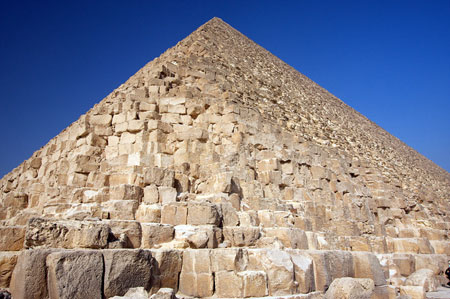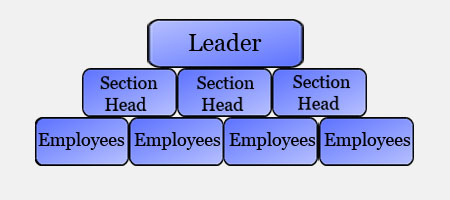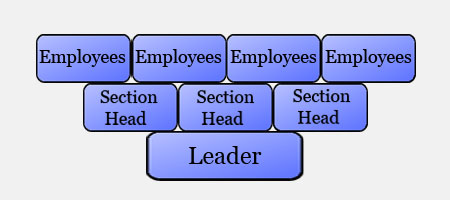
Over the weekend, I watched a fascinating documentary about the various pyramids built during the early dynasties of the Ancient Egyptian civilization, the most famous of these being the Giza pyramids found just outside of Cairo. Over the course of the documentary, Egyptologists shared new theories about how these magnificent structures were built based on the latest findings of the last decade or so. As the archaeologists explained their discoveries, I found myself thinking about the pyramid shape we use to define an organization’s leadership and how – much like the Egyptologists were doing – it might be time to revise our own assumptions over how this particular pyramid should be built.
When we map out a company’s organizational structure, it often resembles the form of a pyramid, where the leader resides at the top, the various section heads taking the next tier, and the general employee workforce occupying the bottom section of the triangular shape:

In describing the construction of the Great Pyramid at Giza, Egyptologists mentioned how it used to be crowned at the top with a gold-leaf capstone. In some ways, this mirrors how many view leadership – as the golden pinnacle of the workplace, the ultimate position of authority and respect – and why some are eager to reach and hold onto this particular position in their organization.
If we look more closely at how the pyramid is constructed, we’ll see that the stone blocks at the bottom are far larger than those at the top, a necessary building requirement as the lower blocks have to be able to absorb more weight than those found higher up in the building for it to be structurally sound.
Indeed, it’s because of the strength of these lower stone blocks in handling the pyramid’s massive weight that this structure has been able to endure for thousands of years. If we were to remove a large number of these stone blocks from the bottom, the pyramid would soon fall apart, with the gold capstone – had it still been present – ending up in a mass of rubble.
Referring back to the organizational diagram above, this idea about where the source of the pyramid’s structural strength lies translates very easily into the setup of the modern-day organization – where it’s the employees in the workplace, more than the leaders above, that define an organization’s strength and durability. And yet, what about defining the true role of leadership in today’s environment? While some businesses might insist on perpetuating the idea of leadership being this gold capstone at the top of their organization, it’s becoming clear that such thinking will not help companies ride the current waves of economic upheaval.
In fact, a more accurate representation of a leader’s role in their organization would be an inverted pyramid as seen in the following image:

In this organizational diagram, we can draw the understanding that the leader – occupying the bottom portion of this inverted pyramid – is now basically holding the rest of the company up; that any decisions or results lie squarely on their shoulders in terms of how well the structure can maintain this balance. Certainly, this is a more accurate representation of a leader’s role in their organization than simply being someone who is propped up by those who work in the lower levels.
But in looking at this altered view of the traditional model of an organization’s structure, we can also draw another important point about leadership. Specifically, that the true role of a leader is to support everyone else in the company. Indeed, it becomes clear that the ability of the company to remain standing upright – and not falling to one side or the other – is a function of the ability of its leader to manage all the needs of their employees, so they can do their part in creating and maintaining this shape which defines the nature of their company.
It’s understandable that companies would like to emulate the pyramids of Ancient Egypt given its strength, longevity, and ability to withstand various assaults on its structure. At the same time, though, we must remember that the pyramids are also static and unmoving structures that are unable to adapt to changes in its surrounding, making them more vulnerable than we might think because of their enormous size.
By appreciating the true nature of where the strengths of our organization originate, and what the true role of leadership is in today’s environment, companies might stand a better chance of mirroring the strength of the Giza pyramids, while remaining capable of adapting to whatever challenges tomorrow might bring.

Great post and I had a couple of thoughts after I read it.
One, when you invert the pyramid, you create a situation where the entire structure of the org depends on having great leadership. should the leader not be successful, be greedy or not have the team's interest as primary, the organization will certainly collapse. On the other side, if the team is strong, sometimes they can survive a leadership collapse and actually emerge. Perhaps there is a needed tension between both models and that organizations change over the various stages to adjust to the leadership and the needs of the org? I am intrigued by Simon Sinek's " Start with Why" thinking and what impact that has on the form of the organization. He seems to argue that the leader comes first and then the org thrives.
Also, how does the pyramid look when the org is super flattened?
Hi Jim,
Thanks for the great comment. I think there's no question that how one treats the role of being a leader directly impacts whether your employees are full participants in the shared goal or whether they simply phone it in. Indeed, I surmise that's why there is so much being written about leadership and being effective in this role as organizations do recognize how critical this function is to their success.
I would assume what Sinek is inferring to is the fact that any process, any idea or goal must have its origin in the group's leadership as it's he responsibility of the leader to both define the organization's vision and keep their eyes on the bigger picture to assess how much their efforts are driving them toward reaching that goal. In this light, it makes sense that "the leader comes first" as they have to define where they need to go, leaving those under their stewardship to figure out what would be the best approach to making it happen.
It's for this reason that I think the answer to your question regarding the shape of a super flattened organization would simply be a shorter pyramid since the fact is that as we move toward more and more specialized employees (compared to the generalist workforces that were predominant in the early decades of the 20th Century), we will need more than ever someone at the top to help direct the efforts of the different individuals/teams toward a common goal. Indeed, I'm reminded of something Peter Drucker once spoke about when he talked about orchestras and how a trumpet player has no interest in becoming a bassoonist; instead, his focus is on improving his own craft, of how he plays his own instrument. I think the same is true of today's workforces, where it's no longer simply about moving up the organizational chart for people to feel growth or development of their talents. Instead, the focus is shifting to how they can keep building on their speciality toward becoming the best player of that skill in their team.
Thanks again, Jim, for the thoughtful comment. Glad you enjoyed this piece and I appreciate your sharing the thoughts it brought to mind.
Great article…Enjoyed reading…Thank you Tanveer…
That's a pretty good representation. Sadly I've seen a lot of positions at my job where the 'leader' is really just a person used to take blame. They haven't been given enough power to actually take action. Which makes me sad for them, because they just take the blunt of the abuse without being able to do much. The higher ups just sort of shove everything on to them. Who themselves do a lot of "passing the buck" so to speak..
I couldn't agree more with the inverted pyramid concept. The leader is located at the bottom because he/she has to look over everyone in the organization, instead of looking down. This makes sense in every type of organization. A team's success depends mainly on effective management; rest assured that every team member is doing his part in order to achieve organizational goals.